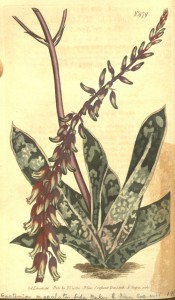Gasteria obliqua (Aiton) Duval
A very variable succulent, as attested by the large number of synonyms. It has 2-ranked leaves, to 25cm long, green banded with paler dots, the inflorescence to 90cm, unbranched, the flowers small, tubular and scarlet. [RHSD, Hortus].
Horticultural & Botanical History
Macarthur’s Aloe lingua is difficulty to identify definitely as a number of plants have been given this name. It is undoubtedly one of the plants grown commonly in England in the first quarter or so of the 19th century under this name. The details given here are for Gasteria obliqua (Aiton) Duval which should be taken as illustrative of the plant grown rather than a definitive identification.
Ker Gawler described three plants under the name of Aloe lingua. The first, Aloe lingua var. crassifolia is a ‘Cape species, some of the varieties of which are said by Thunberg to grow on the top of Roodesand mountains near the waterfall. We have never yet seen any figure of our present variety, which was cultivated by Miller in 1731.
Our drawing was taken at Mr. Malcolm's Nursery, Kensington. Now common. We cannot agree with Mr. Haworth in making this a distinct species; not finding characters sufficient to distinguish it by; his character of “margines integerrimae” is not by any means constant. The outer surface of the leaves when carefully examined will be found to be dotted or chagreened in the manner of a spider’s skin; they are also curiously conduplicate at their bases. This plant is propagated by offsets, is a free blower, and of easy culture.’ [BM t.838/1804]. This is probably a form of Gasteria nigricans Haw.
His next plant, Aloe lingua var. alpha, the Narrow-leaved Tongue Aloe, simply notes: ‘For our observations on this species see above, No. 838. Why the flowers are described as “erecti” in most books, we are at a loss to say.’ [BM t.979/1806]. This is now considered to be a form of Gasteria obliqua (Aiton) Duval [PHS p.6/1809] and is the main description given here.
Finally Aloe lingua is described by Ker Gawler as a ‘native of the Cape of Good Hope. One of the commonest ornaments of our greenhouses and parlour windows. Cultivated by Miller. Blooms most part of the summer. We have erroneously given, in No. 979, a variety of maculata for a variety of this species. Propagated with the greatest facility by offsets. We are obliged to Mr. Haworth for the specimens of all the varieties here engraved. Note: In No. 979, we have by mistake published for a variety of Aloe Lingua, a plant which is more apparently a variety of the A. maculata of No. 765. So that the whole of that article should be expunged and the following substituted in its place.’ There follows the usual latin description. [BM t.1322/1810]. The plant figured and described is now thought to be a variety of Gasteria verrucosa Duval [PHS p.6/1809]. It differs from lingua mainly in having a roughened surface and white tubercles on the surface.
History at Camden Park
Aloe lingua is marked with a ‘c’ in an 1836 edition of Loddiges’ catalogue held at Camden Park [CPA]. In William Macarthur’s code, used and explained elsewhere, this means grown at Camden. It is almost certain that it was grown in the gardens around this time but may have been short lived as it did not appear in the catalogues.
Notes
Aloe linguiformis is figured in Plantarum Historia Succulentarum [PHS p.67/1799-1837].
Published Apr 01, 2010 - 12:51 PM | Last updated Mar 23, 2012 - 01:06 PM
| Family | Aloaceae |
|---|---|
| Category | |
| Region of origin | South Africa |
| Synonyms |
|
| Common Name | Tongue aloe |
| Name in the Camden Park Record |
Aloe lingua |
| Confidence level | medium |


